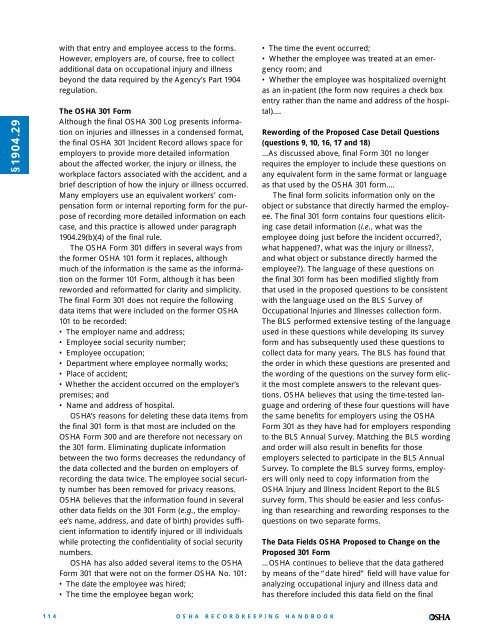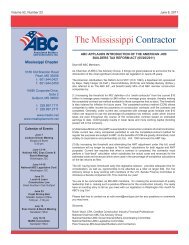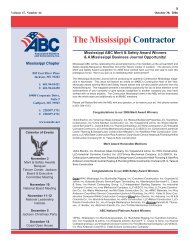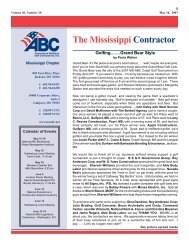OSHA Recordkeeping Handbook - Msabc.net
OSHA Recordkeeping Handbook - Msabc.net
OSHA Recordkeeping Handbook - Msabc.net
Create successful ePaper yourself
Turn your PDF publications into a flip-book with our unique Google optimized e-Paper software.
§1904.29with that entry and employee access to the forms.However, employers are, of course, free to collectadditional data on occupational injury and illnessbeyond the data required by the Agency’s Part 1904regulation.The <strong>OSHA</strong> 301 FormAlthough the final <strong>OSHA</strong> 300 Log presents informationon injuries and illnesses in a condensed format,the final <strong>OSHA</strong> 301 Incident Record allows space foremployers to provide more detailed informationabout the affected worker, the injury or illness, theworkplace factors associated with the accident, and abrief description of how the injury or illness occurred.Many employers use an equivalent workers’ compensationform or internal reporting form for the purposeof recording more detailed information on eachcase, and this practice is allowed under paragraph1904.29(b)(4) of the final rule.The <strong>OSHA</strong> Form 301 differs in several ways fromthe former <strong>OSHA</strong> 101 form it replaces, althoughmuch of the information is the same as the informationon the former 101 Form, although it has beenreworded and reformatted for clarity and simplicity.The final Form 301 does not require the followingdata items that were included on the former <strong>OSHA</strong>101 to be recorded:• The employer name and address;• Employee social security number;• Employee occupation;• Department where employee normally works;• Place of accident;• Whether the accident occurred on the employer’spremises; and• Name and address of hospital.<strong>OSHA</strong>’s reasons for deleting these data items fromthe final 301 form is that most are included on the<strong>OSHA</strong> Form 300 and are therefore not necessary onthe 301 form. Eliminating duplicate informationbetween the two forms decreases the redundancy ofthe data collected and the burden on employers ofrecording the data twice. The employee social securitynumber has been removed for privacy reasons.<strong>OSHA</strong> believes that the information found in severalother data fields on the 301 Form (e.g., the employee’sname, address, and date of birth) provides sufficientinformation to identify injured or ill individualswhile protecting the confidentiality of social securitynumbers.<strong>OSHA</strong> has also added several items to the <strong>OSHA</strong>Form 301 that were not on the former <strong>OSHA</strong> No. 101:• The date the employee was hired;• The time the employee began work;• The time the event occurred;• Whether the employee was treated at an emergencyroom; and• Whether the employee was hospitalized overnightas an in-patient (the form now requires a check boxentry rather than the name and address of the hospital)....Rewording of the Proposed Case Detail Questions(questions 9, 10, 16, 17 and 18)...As discussed above, final Form 301 no longerrequires the employer to include these questions onany equivalent form in the same format or languageas that used by the <strong>OSHA</strong> 301 form....The final form solicits information only on theobject or substance that directly harmed the employee.The final 301 form contains four questions elicitingcase detail information (i.e., what was theemployee doing just before the incident occurred?,what happened?, what was the injury or illness?,and what object or substance directly harmed theemployee?). The language of these questions onthe final 301 form has been modified slightly fromthat used in the proposed questions to be consistentwith the language used on the BLS Survey ofOccupational Injuries and Illnesses collection form.The BLS performed extensive testing of the languageused in these questions while developing its surveyform and has subsequently used these questions tocollect data for many years. The BLS has found thatthe order in which these questions are presented andthe wording of the questions on the survey form elicitthe most complete answers to the relevant questions.<strong>OSHA</strong> believes that using the time-tested languageand ordering of these four questions will havethe same benefits for employers using the <strong>OSHA</strong>Form 301 as they have had for employers respondingto the BLS Annual Survey. Matching the BLS wordingand order will also result in benefits for thoseemployers selected to participate in the BLS AnnualSurvey. To complete the BLS survey forms, employerswill only need to copy information from the<strong>OSHA</strong> Injury and Illness Incident Report to the BLSsurvey form. This should be easier and less confusingthan researching and rewording responses to thequestions on two separate forms.The Data Fields <strong>OSHA</strong> Proposed to Change on theProposed 301 Form...<strong>OSHA</strong> continues to believe that the data gatheredby means of the “date hired” field will have value foranalyzing occupational injury and illness data andhas therefore included this data field on the final114<strong>OSHA</strong> RECORDKEEPINGHANDBOOK







